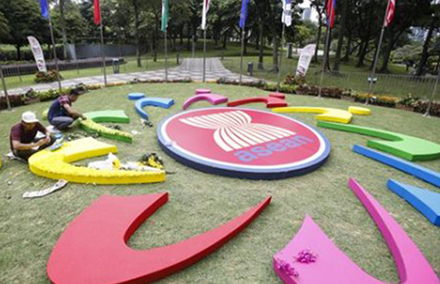
Regional organisation continues to stumble in its quest for further integration.
2015 was meant to be a deadline for ASEAN.
By the end of the year the final phases of the three pillars of ASEAN’s nascent community (political-security, economic and socio-cultural) were to be completed, ushering in a new phase of regional cooperation.
Right on schedule, on 22 November at the 27th ASEAN Summit, Heads of State and Government released the Kuala Lumpur Declaration on the Establishment of the ASEAN Community – seemingly celebrating the successful completion of ASEAN’s community building project.
But all is not as it seems.
The leaders also endorsed ASEAN 2025 as their new road map and blueprint for future ASEAN activities. It paints a very different picture to the Kuala Lumpur Declaration, and talks of completing the commitments that were originally intended to be in place before 2015.
The ASEAN Community has been established, but it has not been finalised, much less completed. ASEAN 2025, far from presaging a triumphant next chapter in regional cooperation, is a far more complex document that talks to the enduring weaknesses of ASEAN as much as its success.
The incompleteness of the ASEAN Economic Community, meant to result in a single market, increased competitiveness, equitable economic development and greater integration into the global economy, reveals that ASEAN is struggling to convert its long-term success in cooperation into meaningful integration.
What we are seeing is the continuation of the long-standing priority of political thinking. Economic cooperation from ASEAN’s foundation in 1967 was always designed for political ends – trust building between elites and strengthening national governments.
Political thinking is fine when designing cooperative endeavours. But it serves very poorly as a way to push through economic integration because so much of that is against short-term political self-interest; witness Indonesia’s increasing hostility to economic integration where it threatens domestic industries with cheap, unfettered, competition.
In turn, the troubles faced by the economic community in reaching its 2015 goals, let alone moving beyond them, imperil ASEAN activities elsewhere because ASEAN has yet to cement a firm basis for those reforms.
ASEAN 2025 does not just look backwards to commitments yet to achieve, but also includes further new commitments to be developed over the next decade.
But, reviewing existing activities and building new ones are goals both weakened by the lack of a stronger economic grounding for ASEAN regionalism and the predominance of diverging political sentiment at the heart of the regional project.
ASEAN 2025 may talk of building new human rights commitments, furthering gender mainstreaming, and building resilience to traditional and non-traditional security threats, but these laudable goals need political agreement if they are ever to have a meaningful life beyond the pages of an ASEAN blueprint.
None of this is to say that ASEAN 2025 is destined to fail anymore than ASEAN itself will.
Indeed the ‘establish and then finalise’ approach matches with ASEAN’s traditional process oriented method which has gotten it across the line in the 50 years since 1967. But it does illustrate that the ASEAN Community is very much a traditional product, not a radical departure from received wisdom.
This traditionalism is going to be the key problem, and source of much conflict, beyond 2015.
The continued primacy of political self-interest will stymie efforts to deepen ASEAN’s commitments in contentious areas and be subject to increasingly vociferous criticism from those member states who wish to progress further, faster, in some areas than others. As a result, ASEAN’s community won’t be one of harmony but one of on-going tension.
Beyond tensions between governments, the growing on paper commitments and continued failure to meet them exposes ASEAN to withering critique from civil society actors, further limiting the ‘permissive space’ of politicians in democratic member states to negotiate the political compromises that ASEAN is built upon and that more authoritarian members expect.
We can conclude that the ASEAN Community has solved few of Southeast Asia’s problems while actually introducing a number of new ones. The one problem it has solved, however, and this is something that considerably tempers my scepticism, is that it has maintained the interest of 10 very different members in the regional project.
The ASEAN Community has allowed discussions to occur between members on contentious issues in a way that keeps all members at the table – the community retains value because it is discussed, even if it is not agreed.
The question now, however, is whether or not it is also a sufficient achievement to protect ASEAN from the ramifications of its incomplete community after 2015.
ASEAN 2025 is subtitled ‘forging ahead together’. Forging ahead to where? In the absence of a destination the likely result is less forging ahead and more moving in circles.
Dr Mathew Davies is a Fellow in the Coral Bell School of Asia Pacific Affairs at the Australian National University. His research focuses on regional order in Southeast Asia.
 Facebook
Facebook  Twitter
Twitter  Soundcloud
Soundcloud  Youtube
Youtube  Rss
Rss 